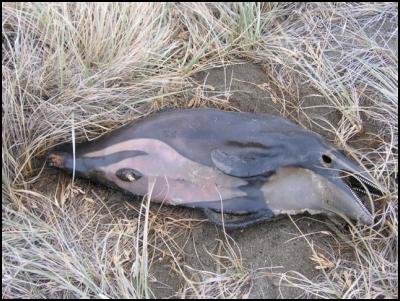Tally of mutilated Hector's dolphins grows
Tally of mutilated Hector's dolphins
grows

Hector's dolphins are being killed and mutilated, according to evidence from the Department of Conservation.
Forest & Bird obtained data from DOC under the Official Information Act about the number of Hector's and Maui's dolphins found mutilated round New Zealand's coastline. The records show there have been 36 cases of dolphins found mutilated since 1980, including five cases from the 1980s, 14 cases from the 1990s and 17 cases since 2000.
Five dolphins had their bellies slit open, one in 2004 had its head cut off and had been hit with a blunt instrument, eight had their tails or tail flukes cut off, two had fins cut off, two had been filleted, one was gutted and another nine dolphin carcasses had knife marks on them.
In one case in 1990 a dolphin skull was found that definitely showed it had been shot, with clear entry and exit wounds, and in another case, in 1989, a carcass was found with a partially severed head that had probably also been shot. In another case in 2003, a dolphin showing net marks was found cut in half (the official data notes that this may have been done to evade discovery).
In 15 cases the dolphins were known to have been killed in set nets or had set net marks on their bodies.
The mutilated bodies were found on beaches around the country, and post mortems were done by Massey University pathologists.
Forest & Bird Marine Conservation Advocate Kirstie Knowles says it is feared that mutilations may be inflicted by fishers who have accidentally caught Hector's dolphins in their nets and are trying to hide the evidence by cutting up the dolphins and burying the body parts or letting them sink.
"It is more difficult for pathologists to determine the cause of death if a dolphin body is mutilated. It is not possible to definitely attribute the mutilations to any individuals or groups, but the fishing industry is keen to avoid tougher measures to protect dolphins from being tangled in fishing nets."
Forest & Bird wants a ban on set nets, which are used to catch fish in coastal waters where Hector's and Maui's dolphins live. The small dolphins get tangled in the nets and drown.
Hector's dolphins are an endangered species. A sub-species, Maui's dolphin, numbers just 111 individuals, and is critically endangered.
In May the government announced measures to protect Hector's and Maui's dolphins, including marine mammal sanctuaries and bans on set netting in the coastal waters where the dolphins are most often found.
Five commercial fishing companies have legally challenged the fishing measures, and the High Court will hear the case in April. Meanwhile, an injunction is in place so commercial set net fishing can continue in some areas where Hector's and Maui's dolphins are found.
Forest & Bird advises anyone who finds dead dolphins or other marine mammals to immediately report the death to DOC and report any illegal fishing activity to the Ministry of Fisheries.
ENDS


 Gordon Campbell: On The Public Sector Carnage, And Misogyny As Terrorism
Gordon Campbell: On The Public Sector Carnage, And Misogyny As Terrorism National Maori Authority: Maori Authority Warns Government On Fast Track Legislation
National Maori Authority: Maori Authority Warns Government On Fast Track Legislation NZ Government: Comprehensive Partnership The Goal For NZ And The Philippines
NZ Government: Comprehensive Partnership The Goal For NZ And The Philippines DoC: Canterbury Spotted Skink In Serious Trouble
DoC: Canterbury Spotted Skink In Serious Trouble Te Pāti Māori: Oranga Tamariki Cuts Commit Tamariki To State Abuse
Te Pāti Māori: Oranga Tamariki Cuts Commit Tamariki To State Abuse NZCTU: Inflation Data Shows Need For A Plan On Climate And Population
NZCTU: Inflation Data Shows Need For A Plan On Climate And Population Statistics New Zealand: Annual Inflation At 4.0 Percent
Statistics New Zealand: Annual Inflation At 4.0 Percent


